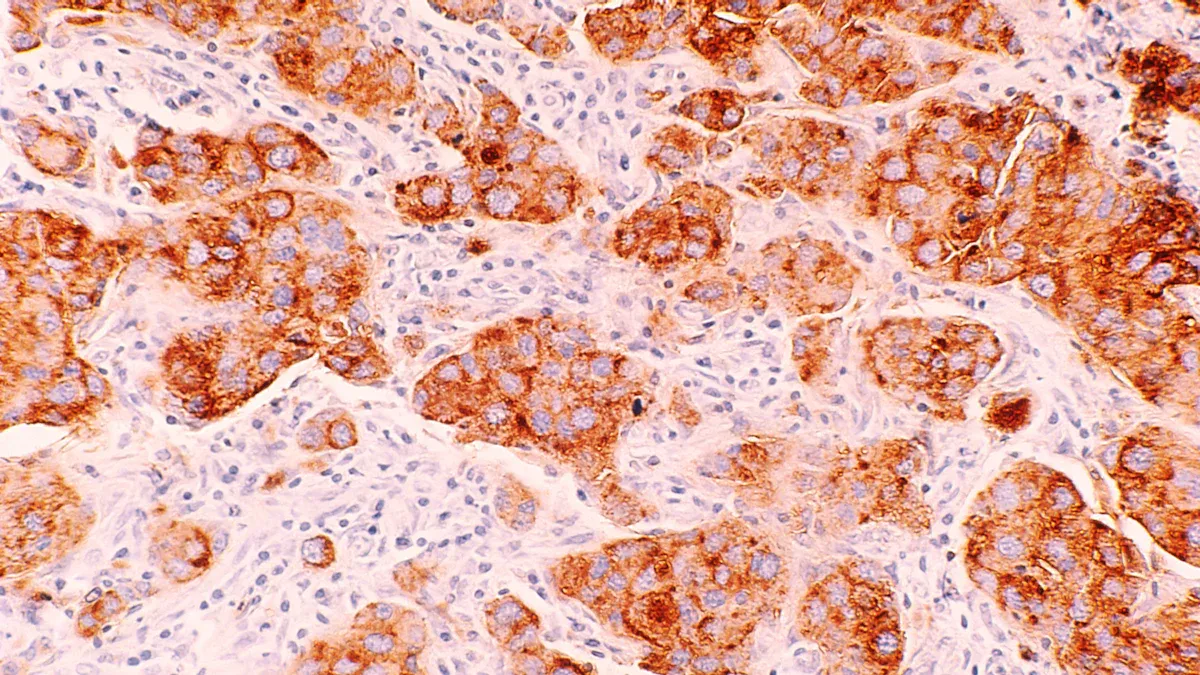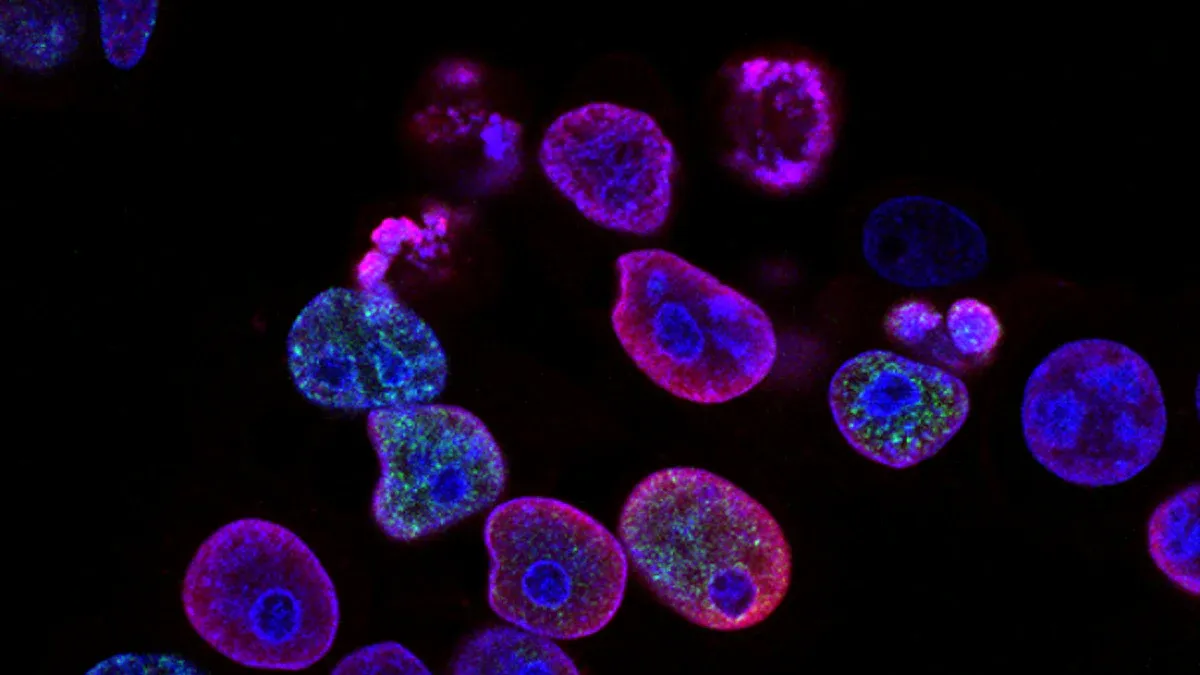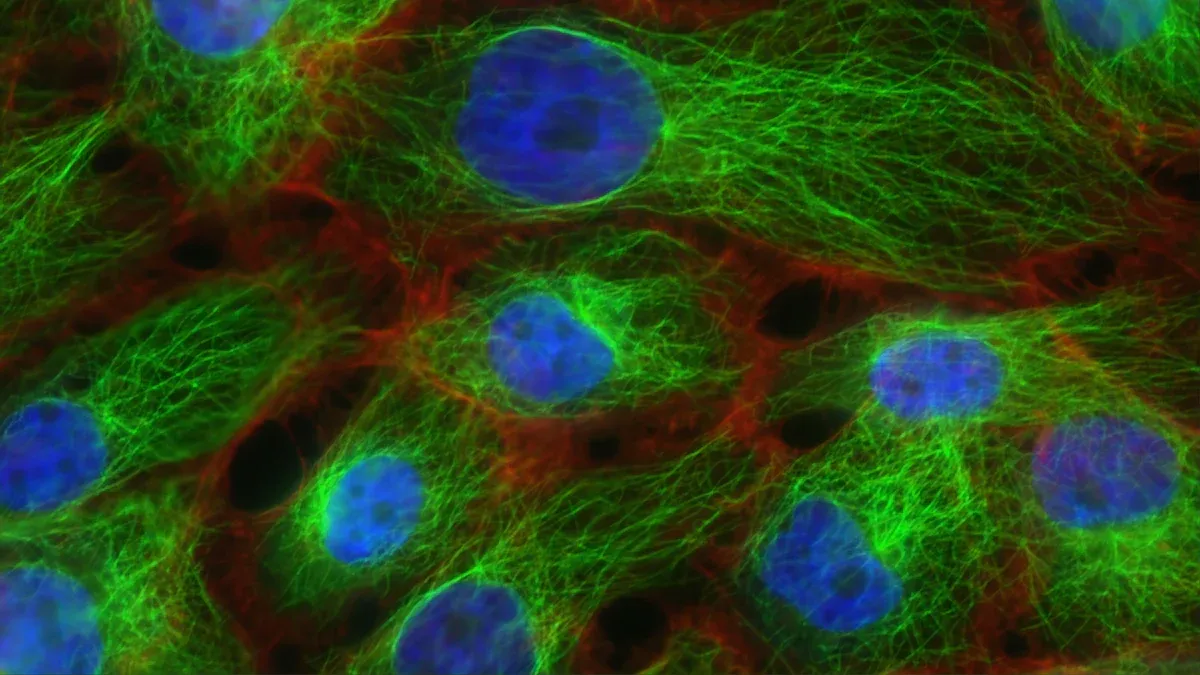What Is Invasive Cribriform Carcinoma of the Breast?

Invasive cribriform carcinoma of the breast, also termed invasive cribriform carcinoma, represents a rare and distinct subtype of breast cancer. This form of cancer accounts for about 0.4% of all primary breast carcinomas, making it an uncommon diagnosis. Characterized by its unique cribriform patterns, more than half of the tumor is composed of small, uniform cells arranged in sieve-like structures. These cells frequently test positive for estrogen and progesterone receptors, while HER2 amplification is rarely observed. Compared to other types of breast cancer, invasive cribriform carcinoma of the breast, also termed invasive cribriform carcinoma, typically exhibits a lower tumor grade, smaller size, and a more favorable prognosis.
Key Takeaways
Invasive cribriform carcinoma is a rare breast cancer. It makes up about 0.4% of all cases. Its special cribriform pattern helps doctors identify it.
This cancer usually has a better outcome than others. Smaller tumors and lower grades mean higher chances of survival.
Regular check-ups and self-checks are very important. Finding it early makes treatment work much better.
Treatment often includes surgery, radiation, and hormone therapy. It is planned based on the person’s needs and cancer type.
Staying healthy can lower the chance of getting this cancer. It also helps prevent other types of breast cancer.
Understanding Invasive Cribriform Carcinoma of the Breast

What Is Invasive Cribriform Carcinoma?
Invasive cribriform carcinoma of the breast, also termed invasive cribriform carcinoma, is a rare type of breast cancer with unique histological features. The tumor cells form a cribriform pattern, which resembles a Swiss cheese-like structure. These patterns consist of small, uniform cells with amphophilic cytoplasm and indistinct boundaries. The nuclei are small to medium in size, and the cribriform areas make up more than 50% of the tumor. Other parts of the tumor may display tubular or different histopathological patterns. This distinct structure helps pathologists identify and diagnose this specific cancer type.
How Does It Differ From Other Breast Cancers?
Invasive cribriform carcinoma of the breast also termed invasive cribriform carcinoma, stands out due to its less aggressive nature. Unlike invasive ductal carcinomas (IDCs), it typically has smaller tumor sizes and lower grades. The cribriform pattern, with its well-defined rounded spaces and secondary glandular structures, is a hallmark of this cancer. Additionally, it has a higher rate of estrogen receptor positivity and a lower likelihood of spreading to lymph nodes. These characteristics contribute to a better prognosis and higher survival rates compared to other invasive breast cancers.
Who Is at Risk for Invasive Cribriform Carcinoma?
Certain lifestyle and environmental factors may increase your risk of developing invasive cribriform carcinoma. These include drinking alcohol, smoking, and being overweight or obese. A lack of physical activity can also contribute to the risk. Additionally, working night shifts or being exposed to high levels of light at night may play a role. While these factors are not specific to this cancer type, they are linked to an overall higher risk of breast cancer. Maintaining a healthy lifestyle can help reduce your risk.
Symptoms of Invasive Cribriform Carcinoma
Common Symptoms of Invasive Cribriform Carcinoma
Invasive cribriform carcinoma of the breast also termed invasive cribriform carcinoma, often presents with subtle or no symptoms in its early stages. Many individuals first notice a lump during self-examination or through routine screening. These masses are typically painless and may go unnoticed without regular check-ups. In some cases, areas of microcalcification appear on mammograms, which occurs in about 32% of patients.
Rarely, you might observe more noticeable changes, such as skin ulceration or an inverted nipple. While these symptoms are uncommon, they should prompt immediate medical attention. Lymph node involvement is another possible sign, occurring in approximately 15.9% to 25.5% of cases. Recurrences near the surgical site can also happen, though this is less frequent with early detection and proper treatment.
Overlapping Symptoms With Other Breast Conditions
The symptoms of invasive cribriform carcinoma can overlap with those of other breast conditions, making diagnosis challenging without medical evaluation. For example, benign breast lumps or cysts may feel similar to cancerous masses. Skin changes, such as redness or dimpling, might mimic inflammatory breast cancer or infections like mastitis.
Nipple changes, including inversion or discharge, could also result from non-cancerous conditions. However, these symptoms should never be ignored. Regular screenings and consultations with your healthcare provider are essential for distinguishing invasive cribriform carcinoma from other breast issues. Early detection plays a critical role in improving outcomes and ensuring effective treatment.
Diagnosing Invasive Cribriform Carcinoma

Diagnostic Tests for Invasive Cribriform Carcinoma
Imaging Techniques
Detecting invasive cribriform carcinoma of the breast also termed invasive cribriform carcinoma, often begins with imaging tests. These tests help identify abnormalities in breast tissue. However, the radiological features of this cancer are not unique and may resemble other breast carcinomas. Common imaging techniques include:
Mammography: This is often the first step in identifying suspicious areas in the breast. It can reveal masses or microcalcifications that may indicate cancer.
Ultrasound: This test provides detailed images of breast tissue and helps determine if a lump is solid or fluid-filled.
Magnetic Resonance Imaging (MRI): This technique uses magnetic fields to create detailed images, which can help detect tumors that are not visible on mammograms.
Computed Tomography (CT): Although not specific to this cancer type, CT scans may incidentally detect invasive cribriform carcinoma during imaging for other conditions.
While these methods are effective for detecting abnormalities, they cannot confirm the diagnosis. Further testing is necessary to identify the specific type of cancer.
Biopsy and Pathology
A biopsy is essential for diagnosing invasive cribriform carcinoma. During this procedure, a small sample of breast tissue is removed and examined under a microscope. Pathologists analyze the tissue to identify the unique cribriform patterns that define this cancer. These patterns include sieve-like structures formed by small cells with indistinct boundaries. The presence of microcalcifications, mucins, and apical snouts further supports the diagnosis. This detailed analysis ensures an accurate identification of the cancer type.
Role of Pathologists in Identifying Cribriform Patterns
Pathologists play a critical role in diagnosing invasive cribriform carcinoma. They examine the tissue samples for specific microscopic features. Cribriform areas, which make up more than 50% of the tumor, are a key indicator. These areas consist of small cells with sharp nuclear membranes and small-to-medium nuclei. The cells form a Swiss cheese-like structure with sieve-like holes. Pathologists also look for additional features, such as microcalcifications and mucins, to confirm the diagnosis. Their expertise ensures that you receive an accurate and timely diagnosis, which is crucial for effective treatment.
Treatment Options for Invasive Cribriform Carcinoma
Surgical Options
Lumpectomy
A lumpectomy is a common surgical option for treating invasive cribriform carcinoma. This procedure removes the tumor and a small margin of surrounding healthy tissue while preserving most of the breast. Patients with invasive cribriform carcinoma often have higher success rates with lumpectomy compared to those with other breast cancer types. Studies show that 67.9% of patients with this cancer undergo lumpectomy, compared to 60.4% of patients with invasive ductal carcinoma. This difference highlights the favorable prognosis associated with invasive cribriform carcinoma. After surgery, adjuvant radiation therapy is often recommended to reduce the risk of recurrence.
Mastectomy
In some cases, a mastectomy may be necessary. This procedure involves removing the entire breast to eliminate cancerous tissue. While less common for invasive cribriform carcinoma, mastectomy may be chosen if the tumor is large or if multiple areas of the breast are affected. The decision between lumpectomy and mastectomy depends on factors such as tumor size, location, and your personal preferences. Consulting with your healthcare provider can help you determine the best surgical approach for your situation.
Radiation Therapy
Radiation therapy often follows surgery to target any remaining cancer cells. This treatment uses high-energy rays to destroy microscopic cancer cells that may not have been removed during surgery. For invasive cribriform carcinoma, radiation therapy is typically administered at rates similar to those for other breast cancers. It plays a crucial role in reducing the likelihood of recurrence, especially after a lumpectomy. Your doctor will create a personalized radiation plan based on your specific needs.
Hormonal Therapy
Hormonal therapy is an essential treatment for invasive cribriform carcinoma of the breast also termed invasive cribriform carcinoma. This cancer often tests positive for estrogen and progesterone receptors, meaning hormones can fuel its growth. Hormonal therapy works by blocking these hormones or reducing their levels in your body. Drugs like tamoxifen prevent estrogen from binding to cancer cells, effectively slowing or stopping their growth. This therapy is particularly effective for hormone-sensitive cancers and is often part of a comprehensive treatment plan.
Chemotherapy
Chemotherapy plays a vital role in treating invasive cribriform carcinoma of the breast also termed invasive cribriform carcinoma, especially in cases where the cancer shows signs of spreading or when other treatments are insufficient. This approach uses powerful drugs to target and destroy cancer cells, preventing them from growing or dividing further. While chemotherapy is not always the first line of treatment for this type of cancer due to its less aggressive nature, it becomes essential in specific scenarios.
Doctors often recommend different chemotherapy regimens based on your unique condition. These regimens combine various drugs to maximize their effectiveness. Below is a table summarizing some commonly used chemotherapy combinations:
Regimen Type | Drugs Used |
|---|---|
Triple Therapy | Cyclophosphamide, Epirubicin, Fluorouracil |
Double Therapy | Docetaxel, Epirubicin |
Triple Therapy | Cyclophosphamide, Doxorubicin, Fluorouracil |
Each regimen targets cancer cells in a slightly different way, ensuring a comprehensive attack on the disease. For example, triple therapy regimens often combine drugs like Cyclophosphamide and Fluorouracil to disrupt DNA replication in cancer cells, while Epirubicin or Doxorubicin enhances the overall effectiveness.
You may experience side effects during chemotherapy, such as fatigue, nausea, or hair loss. These effects occur because chemotherapy drugs can also impact healthy cells. However, advancements in medicine have made it possible to manage these side effects more effectively. Your healthcare team will work closely with you to minimize discomfort and ensure the best possible outcome.
Chemotherapy, when combined with other treatments like surgery or radiation, can significantly improve your chances of recovery. Discussing your options with your doctor will help you understand how chemotherapy fits into your overall treatment plan.
Prognosis and Outlook for Invasive Cribriform Carcinoma
Survival Rates
Invasive cribriform carcinoma of the breast also termed invasive cribriform carcinoma, has an excellent prognosis compared to other breast cancer types. Studies show that survival rates remain high over time. Below is a table summarizing the overall survival rates for this cancer:
Time Frame | |
|---|---|
3 years | 94.4% |
5 years | 90.3% |
10 years | 100% (pure ICC), 90% (mixed ICC) |
When compared to infiltrating ductal carcinoma (IDC), invasive cribriform carcinoma demonstrates better outcomes. The table below highlights the differences:
Survival Metric | Invasive Cribriform Carcinoma (ICC) | Infiltrating Ductal Carcinoma (IDC) |
|---|---|---|
5-year DSS | 98.8% | 93% |
5-year OS | 95.3% | 90.1% |
These statistics emphasize the favorable outlook for individuals diagnosed with this rare cancer type.
Factors Influencing Prognosis
Several factors can influence your prognosis if you have invasive cribriform carcinoma. These include:
Tumor location
Progesterone receptor (PR) status
Tumor stage (T stage) and metastasis stage (M stage)
Patients with this cancer are often older and have smaller tumors compared to those with infiltrating ductal carcinoma. Hormone receptor positivity, particularly for estrogen and progesterone, also plays a critical role in improving outcomes. Smaller tumor size and lower tumor grade further contribute to the positive prognosis.
Importance of Early Detection
Early detection significantly improves your chances of a successful outcome. Regular screenings, such as mammograms, can help identify invasive cribriform carcinoma of the breast also termed invasive cribriform carcinoma, at an early stage. When caught early, the cancer is often smaller and less likely to spread, making treatment more effective. Self-examinations and routine check-ups with your healthcare provider are essential steps in catching this cancer early. By staying proactive, you can ensure timely intervention and better long-term results.
Steps to Take After Diagnosis
Consulting a Specialist
After receiving a diagnosis of invasive cribriform carcinoma of the breast also termed invasive cribriform carcinoma, your first step should involve consulting a specialist. A breast cancer specialist, such as an oncologist or breast surgeon, can guide you through the next steps. They will review your medical history, discuss your diagnosis, and explain the available treatment options. Specialists often work as part of a multidisciplinary team, which may include radiologists, pathologists, and oncology nurses. This team approach ensures that you receive comprehensive care tailored to your specific needs.
During your consultation, ask questions about your diagnosis and treatment options. Understanding the details of your condition will help you make informed decisions. You might also consider seeking a second opinion to confirm your diagnosis and explore alternative treatment plans.
Understanding Your Treatment Plan
Your treatment plan will outline the steps needed to manage your condition effectively. It typically includes a combination of therapies designed to target the cancer while preserving your overall health. Below is a summary of common treatments for invasive cribriform carcinoma:
Treatment Type | Percentage of Patients Treated | Description |
|---|---|---|
Surgical Removal | Typically involves breast-conserving surgery or modified radical mastectomies. | |
Radiotherapy | 52.2% | Often used as adjuvant therapy following surgery. |
Chemotherapy | 22.1% | Includes regimens such as triple therapy with cyclophosphamide, epirubicin, and fluorouracil. |
Hormonal Therapy | Nearly 100% | Involves drugs like letrozole, anastrozole, or tamoxifen to reduce estrogen levels. |
Your doctor will explain why specific treatments are recommended based on your tumor’s size, hormone receptor status, and overall health. Understanding your treatment plan will help you prepare for each step and stay actively involved in your care.
Seeking Emotional and Psychological Support
A cancer diagnosis can feel overwhelming, but emotional and psychological support can make a significant difference. You may experience a range of emotions, including fear, anxiety, or sadness. Speaking with a counselor or joining a support group can help you process these feelings. Many hospitals and cancer centers offer resources for patients, including therapy sessions and peer support programs.
Lean on your loved ones for support. Share your feelings with family and friends, and let them know how they can help. Practicing self-care, such as meditation, journaling, or light exercise, can also improve your emotional well-being. Remember, seeking help is a sign of strength, not weakness.
Invasive cribriform carcinoma of the breast also termed invasive cribriform carcinoma, is a rare but distinct type of breast cancer. It accounts for only 0.3% to 0.6% of all breast carcinomas and is characterized by its unique cribriform pattern, resembling Swiss cheese. This cancer type often has a favorable prognosis, with lower rates of lymph node metastasis compared to other breast cancers. Early detection through regular screenings and self-examinations plays a crucial role in improving outcomes. Personalized treatment plans, tailored to the unique characteristics of this cancer, can further enhance recovery and quality of life.
Always consult a healthcare professional for accurate diagnosis and guidance. Their expertise ensures you receive the best care for your specific condition.
FAQ
1. What makes invasive cribriform carcinoma different from other breast cancers?
Invasive cribriform carcinoma grows less aggressively than most breast cancers. Its unique cribriform pattern, resembling a sieve or Swiss cheese, helps pathologists identify it. This cancer often responds well to treatment and has a higher survival rate compared to other invasive breast cancers.
2. Can invasive cribriform carcinoma spread to other parts of the body?
Yes, but it spreads less frequently than other breast cancers. Lymph node involvement occurs in about 15-25% of cases. Early detection and treatment reduce the risk of metastasis and improve outcomes significantly.
3. Is hormonal therapy always necessary for this cancer type?
Hormonal therapy is often recommended because this cancer usually tests positive for estrogen and progesterone receptors. Drugs like tamoxifen or aromatase inhibitors block hormones that fuel cancer growth, making it an effective treatment option.
4. How can you detect invasive cribriform carcinoma early?
Regular mammograms and self-examinations are key. Look for lumps, nipple changes, or skin abnormalities. Early detection through routine screenings improves treatment success and reduces the risk of complications.
5. Does invasive cribriform carcinoma have a good prognosis?
Yes, it has an excellent prognosis. Survival rates are high, with a 5-year disease-specific survival rate of nearly 99%. Early-stage detection and hormone receptor positivity contribute to these favorable outcomes.
Tip: Always consult your doctor if you notice any unusual breast changes. Early action saves lives.
---
ℹ️ Explore more: Read our Comprehensive Guide to All Known Cancer Types for symptoms, causes, and treatments.
See Also
Choriocarcinoma: Understanding Its Nature and Treatment Options
Key Features and Insights About Craniopharyngioma Explained
Exploring Gastrointestinal Carcinoid Tumors: What You Should Know
Identifying Symptoms of Basal Cell Carcinoma: A Guide
Essential Information on Basaloid Squamous Cell Lung Carcinoma
